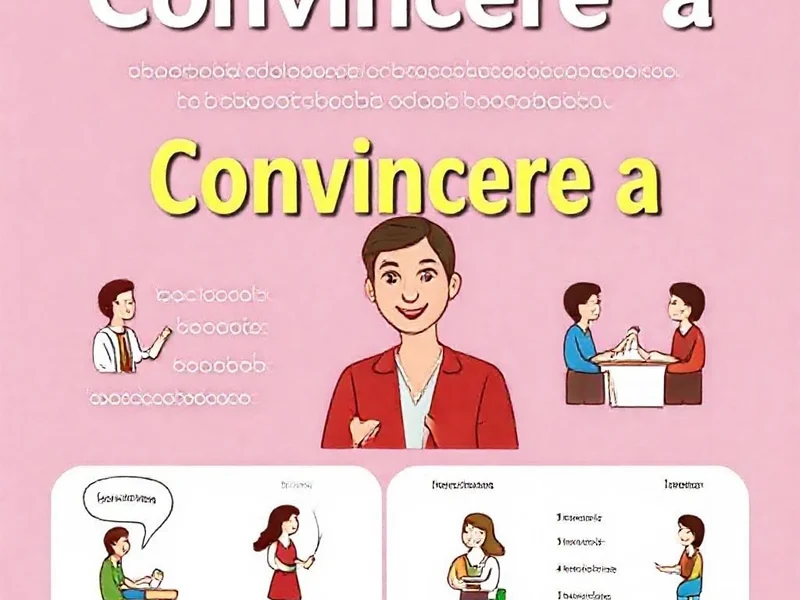How to Use "Convincere a": Meaning and Practical Examples
Hello Italian learners! Learning Italian also means mastering those expressions that make your speech sound natural and authentic. Today we will dive into a very common phrasal verb: convincere a. This verb is essential for communicating in Italian when talking about persuading someone to do something. It often causes confusion, but don’t worry! In this guide, we will explore its meaning, grammatical structure, how it is used with practical examples, and the common mistakes to avoid. Are you ready to master this essential piece of practical Italian vocabulary?

Table of Contents
- What does “Convincere a” mean?
- The Grammatical Structure: How is it Used?
- Sentences and Examples with “Convincere a”
- Crucial Differences: Common Mistakes to Avoid
- Similar or Related Expressions
- Conclusion
What does “Convincere a” mean?
- Literal Meaning: To get a person to agree to perform a specific action.
- Example: "Ha convinto il bambino a mangiare le verdure."
- Figurative Meaning: To influence someone’s will in order to overcome an obstacle or resistance, leading them to a change of behavior or idea that results in an action.
- Example: "Abbiamo convinto la squadra a non arrendersi fino all'ultimo."
More: How to Use Contravvenire a Meaning and Practical Examples Effectively
The Grammatical Structure: How is it Used?
The basic structure to correctly use "convincere a" is simple:
- Formula: [Subject] + convincere + [Person/Direct Object] + a + [Verb in the infinitive]
The verb "convincere" is a transitive verb, which means it requires a direct object (the person or group being convinced). The preposition "a" is fundamental in this construction, because it indicates the direction of the action toward which someone is being persuaded. It is very important to remember that after "a" you must always use a verb in the infinitive. This structure is very common in everyday speech and allows you to clearly express the intent to persuade.
More: How To Use Contribuire a Meaning Usage Practical Examples
Sentences and Examples with “Convincere a”
Here are some examples of how "convincere a" is used in real situations to help you understand its practical use in Italian as a second language:
📍 Family
Person A: "Hai convinto tuo fratello a pulire la sua stanza?"
Person B: "Sì, ma ci è voluto un po'!"
📍 Work
Person A: "Dovremmo convincere il capo a darci un giorno libero."
Person B: "Buona fortuna! Non sarà facile."
📍 Friends
Person A: "Siamo riusciti a convincere Marco a venire con noi al concerto."
Person B: "Fantastico! Pensavo non volesse uscire."
📍 Unexpected Situation
Person A: "Hanno convinto il guidatore a fermarsi dopo l'incidente?"
Person B: "Sì, ma ha cercato di scappare."
📍 Free Time
Person A: "Hai convinto i tuoi amici a provare il nuovo ristorante vegano?"
Person B: "Sì, all'inizio erano scettici, ma ora sono entusiasti!"
More: How to Use Continuare a Meaning and Practical Examples
Crucial Differences: Common Mistakes to Avoid
One of the most common mistakes for Italian learners is confusing the use of "convincere a" with other prepositions or structures that go with the verb "convincere". It is crucial to understand the difference between convincing someone to do an action and convincing someone of a truth or that something is true.
Convincere a + Infinitive
This form, "convincere a", is specific for when you want to persuade someone to carry out an action. Think of a concrete action or behavior.
- Example: "Ho convinto Maria a studiare di più per l'esame." (Here the goal is for Maria to perform the action of studying).
Convincere di/che + Noun/Clause
When instead you want to lead someone to believe in something, to change their opinion about a fact, or to accept a truth, you use "convincere di" followed by a noun or "convincere che" followed by a clause (with the indicative). This is not about an action, but about a belief or conviction.
- Example: "Ho convinto Maria che il mio metodo fosse efficace." (Here the goal is for Maria to believe in the effectiveness of the method).
- Example: "Sono convinto della sua buona fede." (Here you express your own conviction regarding someone’s good faith).
Remembering this distinction will help you use "convincere a" precisely, avoiding misunderstandings and making your Italian sound more natural.
Similar or Related Expressions
To enrich your vocabulary and understand the nuances of the language, here are some expressions similar to "convincere a":
| Similar Expression | Short Meaning | Example |
|---|---|---|
| Persuadere a | To induce someone to do something. | "L'ho persuaso a cambiare idea." |
| Indurre a | To prompt or cause someone to do something. | "Le sue parole lo hanno indotto a riflettere." |
| Spingere a | To encourage or force someone to do something. | "I genitori lo hanno spinto a seguire la sua passione." |
Conclusion
"Convincere a" is essential to express the act of persuading someone to perform an action. Remember: it is always used with the preposition "a" followed by the infinitive of the verb. With practice, it will become a natural expression in your speech. Now it’s your turn! Try writing a sentence with "convincere a" in the comments below. How have you convinced someone (or have you been convinced) to do something recently? Share your experience!